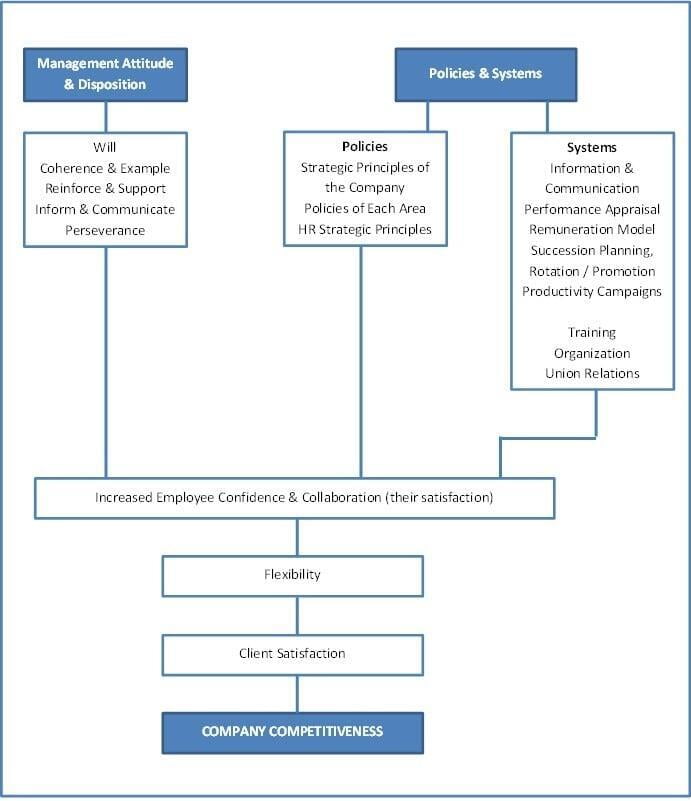
The purpose of HR Marketing is to clarify the role and contribution of HR to the objectives of organizations. To do this, the HR Management must work strategically, effectively direct people in their department and know how to market the work they do.
An HR marketing project must be:
· Attractive: «What I have been told to do is interesting».
· Useful: «What I do is useful for something».
· Motivating: «What I do is good and it helps me».
· Integrating: «I recognize achievements and successes (result) as mine because I carry them out. It is my program and not that of HR ».
We must mention some aspects that we have to keep in mind so that the effort used to "sell" HR to all other departments can be considered a success:
• What is the image of the HR Department within the company?
The false perceptions about HR Department in the rest of the organization must be changed: it can no longer be considered as the "extinguish fires" of the organization.
The theory of marketing is based on the notion that service and performance are as good as the customer thinks and no more. Hence, marketing techniques are ways that we can use to influence what the rest of the organization thinks about the HR Department. To do this, that department must build and maintain a relationship of trust, based on the congruence of what it says and it does and the empathy it shows towards its clients. It should be mentioned that there is almost always a gap between what the HR Department believes the internal clients perceive and what, in reality, they perceive. Thus, a dialogue must be created between the HR Department and its clients to ensure that this gap does not exist.
• The communication approach of the HR function
Comprehensive communication is needed that affects all hierarchical levels and meets client’s needs.
• The performance of the HR function in areas considered critical
It is about achieving added value by creating competitive advantages, from the optimization of products and services to becoming leaders by being part of the change management in the organization.
• Personal characteristics and communication skills of the HR Director
The image of a department depends, in many occasions, on the personal and professional quality of the people who make it up.
To expand this section we will describe the skills that an effective HR Manager should have:
- Persuasion: the capacity for persuasion is to guide and convince others. For such capacity to exist, logical and coherent arguments must be used. On the other hand, we will say that common sense is one of the best allies you can count on. The typical errors of an unclear reasoning are, among others: the use and abuse of generalizations and topics, and of taking something for granted.
- Change Management: in a world where change has become a constant, one must be able to invent the future from the past and the present moment. We cannot settle for the experience and neither jump into the void without taking into account the culture in which we move.
- Communication: the keys to establish an effective communication are based, above all, on the role of the feedback, which is absolutely necessary to be able to verify if the message has been interpreted, or not, erroneously. HR managers must be clear, concise and open to dialogue.
- Creative Thinking: problems - both old and new - demand creative solutions. Human potential is the differentiating factor in the companies of the future. All personnel must be involved in the company by offering new ideas and new strategies: applied imagination must be encouraged. Consequently, an open, progressive mentality must prevail. Brainstorming is one of the techniques that encourage creativity in the company.
- Delegating: it consists of assigning tasks to other people in an appropriate way.
- Empowerment: it is the process of expanding the scope of action and responsibility of people in their work.
- Leadership: the ability to get employees to give their best so that the proposed objectives can be achieved.
- Planning: tasks for forecasting needs, and setting objectives and procedures.
- Strategic Management: companies are - or should be - endowed with a sense of direction and the resources necessary for the objectives to become realities.
- Team Driver (coaching): one of the main responsibilities of managers is to stimulate and obtain maximum performance from their teams. We could compare it with the figure of a team coach.
Once these aspects have been taken into account, we must know the resources we have in order to distribute them. The next step will be to try to set some marketing goals.
This implies, for example:
1. Work together to achieve maximum customer satisfaction.
2. Participate in all markets thanks to the creation of highly competitive products.
3. Permanently improve the activity through creativity and flexibility of work systems.
4. Contribute to progress and social prosperity by improving the quality of life and personal and professional development of people.
It is about building an organization that is capable of assimilating all the changes that may occur in its structure, systems and work methods, and in the attitudes of each and every one of those who work in it so that it can become a flexible and transparent company, with an open and participatory management style.
To achieve the implementation of the aforementioned bases, HR Management must have specific objectives that:
- each employee feels useful and important;
- keep employees informed with absolute transparency and listen to their objections and / or suggestions;
- create an environment in which all members can contribute to the maximum extent of their capabilities;
- stimulate full participation in important matters by continuously expanding the self-direction and self-control of subordinates.
All this perfectly matches the basic principles of many present successful companies, which are the following:
- Flexibility: being open to any change with an agile and effective organization, without barriers where everyone's participation is encouraged.
- Transparency: effective communication of information, ideas and opinions is promoted.
- Impartiality: paying special attention to decision-making based on equal opportunities and treatment.
- People Orientation: the quality of everything that is done, as well as the commitment to customer service, is based on the men and women who make up the organization.
For HR marketing to be effective, the company's philosophy must be deeply understood and apprehended (recognized as one’s own). Therefore, marketing of HR Management should never be an isolated activity in the organization, but an integral part of the strategy of the general management.
Considering the basic principles of the new culture, policies and strategies and the evolution of the HR function, here you have some tools that materialize the management of these resources and that should be the object of HR management marketing plan:
a. Communication Plan:
The communication plan must:
- Facilitate upward communication through a meeting plan that makes it possible to know the general opinion even of blue-collar employees.
- Collect the proposals made by employees for the improvement of the organization; In doing so, a direct feedback system to be established with the company's management.
b. Dynamic HR Management:
A system based on the development of skills and abilities must be implemented through an analysis of positions. This will lead to greater:
- Versatility, rotation and functional mobility.
- Progression, professional development and promotion.
- Organizational flexibility.
- Integration of functions and jobs.
- Greater assignment of responsibilities.
- Reduction of hierarchical levels.
- Training planning.
- Application of new remuneration policies and professional classification systems.
c. Management Skills Program:
- Train in business management techniques of high added value to managers and department heads.
- Emphasize the management role.
- Develop human resources through delegation, communication and analysis, and problem solving.
d. New Role of Line Managers:
- Strengthen the role of managers directly responsible for staff.
- Strengthen the leadership and driving factors of labor and human relations.
- Eliminate the tendency of employees to solve their problems through workers' representatives.
- Reduce the bureaucracy of the processing of applications and complaints.
- Enhance the descending and ascending communication.
- Promote a more agile and effective organization in which all workers participate.
e. Development of Technical Skills of Operative Positions:
- Raise the individual level of the capacity of the operative positions permanently improving their technical and practical knowledge.
- Establish a training process according to the different levels of knowledge with the objective of obtaining technical skill for improvement and management operations.
F. Absenteeism Reduction:
- Determine preventive and corrective actions to keep absenteeism within appropriate levels.
- Improve existing working conditions.
- Integrate risk prevention into the company's activities as a whole.
- Conduct health and prevention campaigns.
- Propose alternatives to the previous bonus systems and social packages.
g. Office Improvement Teams:
- Promote personal and professional development through participation.
- Promote teamwork.
- Foster the spirit of collaboration with the philosophy and objectives of the company.
- Manage work towards continuous improvement and towards the PDCA cycle: P (plan), D (do), C (check) and A (action).
h. Campaign to Prevent Occupational Risk Factors:
- Ensure that levels of accident and absenteeism decrease through the integration of prevention activities.
- Improve jobs.
- Apply prevention measures to both employees and staff of outsourced companies.
- Improve the quality of working life.
- Improve the ergonomics of job positions.
I. IDENTIFICATION OF THE CLIENT
The HR Department must be clear about who their client is, since they should not forget that client also participates in marketing. In this sense, the clients of the HR Department are not only the employees, but also, and preferably, the directors and managers of other areas and divisions and the general management.
According to Clutterbuck & Dearlove (1995), customer identification is closely related to the issue of market segmentation. The main purpose of this segmentation is to establish the different audiences to which the products and services are oriented.
A good approach of the HR Department could be to develop its client-oriented activities from the moment its projects are designed. The HR Department is governed by a perfectly clear maxim: «Offer services with the highest possible quality in response to customer demands».
II. HOW TO IDENTIFY THE NEEDS OF HR CLIENTS?
The fact that clients always have needs does not take away the responsibility to know how they are generated, since the HR professional must be a proactive person. In order to detect the needs, we must have some instruments, such as internal client surveys, climate surveys, communication meetings, performance / progress evaluations, etc.
If a company wants to be competitive and successfully carry out its viability plan, it must create a corporate, liberal and impartial culture, though, by conducting a needs analysis that justifies the cultural change undertaken.
Figure 1. Cultural Changes Requirements

Until a while ago, the adoption of new business strategies was based on organizational and technological changes oriented to manufacturing, which implied a profound labor affectation, which had to be revised to adapt the traditional supervision systems to the new reality faced by the company. That justifies the fact that many companies needed to evolve towards a more flexible, transparent and close to employee and human relations model; that is, according to new corporate philosophy schemes.
Basically, with the policy that is proposed, a cultural change is intended: one must evolve from a situation of rigidity to another of flexibility, from one orientation towards the task to another towards the results, from the specialization to versatility, from the dependence and hierarchy to autonomy and self-control; all for the sake of personal and professional development of the workforce, always from an industrial point of view.
